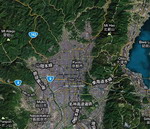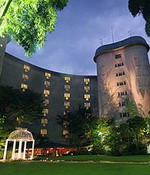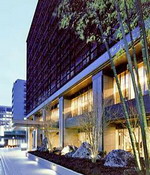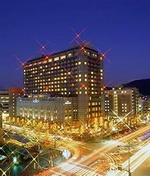|
Search
this site


View
map of Asia

View
map of Japan

View
map of Kyoto

Buy
This Allposters.com
Copyright © All World
Vacation Station
|
 |



|
Featured
Kyoto Hotels
Types
of Accommodations For Travelers to Japan
Hiroshima:
It's more than a mushroom cloud
Interesting
and offbeat places to visit in Tokyo
Japanese
Geisha
Mount
Fuji, the sleeping volcano
Sapporo
Japan - An Introduction
The
Wonderful World of Sushi
Travel
Tokyo Japan
Japan
Travel Books |
Nestled among mountains in Western
Honshu, Kyoto has a reputation worldwide as Japan's most beautiful
city.

Buy
This Allposters.com
|
However, visitors will be
surprised how much work they will have to do to see its beautiful side.
Most visitors' first impressions will be of the urban sprawl of central
Kyoto, around the ultra-modern glass-and-steel train station.
Nonetheless, the persistent
tourist will soon discover Kyoto's hidden beauty in the temples and parks
which ring the city center, and find that the city has even more than meets
the eye.
Kyoto offers an incredible
number of attractions for tourists, and visitors will probably need to
plan an itinerary in advance in order to visit as many as possible. |
 Featured
Kyoto Hotels
Featured
Kyoto Hotels
top
|
Japanese
Geisha by Shane Yen
Featured
Kyoto Hotels
Japanese Geisha have their
roots in female entertainers such as the Saburuko of the 7th century. Japanese
Geishas performs for the nobility and concubines to the emperor. The first
walled-in pleasure quarters were built in Japan in the 16th century. In
the Japanese culture, they were modeled after those of Ming Dynasty China.
After they were relocated in the mid-1600s, they became known as Shimabara
(after a fortress in Kyushu).

| Meanwhile a marshy patch
of land (Yoshi-wara) in Edo had been designated as the site for a brothel
district under the auspices of the Tokugawa shogunate. Strict rules such
as brothels and the like were not allowed to operate outside the district.
Among these rules were that no customers were allowed to stay in a brothel
for more than 24 hours. Any suspicious or unknown visitors were to be reported
to the Office of the City Governor.
With Japan enjoying a long-awaited
period of peace following centuries of civil war, many samurai found that
society no longer had such need of their services. It's thought that many
daughters of these formerly noble families became courtesans, with the
result that quarters such as Yoshiwara and Shimabara were places of refinement
and culture. |

Buy
This Allposters.com
|

Peace also brought an increase
in prosperity and the rise of the merchant class, or chonin. Add that to
the presence of artists and an atmosphere free of the strictures of the
outside world, and it truly was something of an adult amusement park, with
culture thrown in for good measure.
Within the hanamichi there
were many different classes of courtesans, and over the decades the hierarchy
and the standards expected of them changed many times, not always for the
better. The situation deteriorated in the mid-18th century to the extent
that a new form of entertainer emerged in Kyoto and Osaka.

Buy
This Allposters.com
|
The earliest geiko were
men, while the first females, who appeared shortly after, were odoriko
(dancers) or played the shamisen. Female geisha soon became popular enough
to be able to steal clients from the courtesans, and in the case of Yoshiwara
it was decided to start a kenban, or registration system, to keep them
under control and force them to pay taxes.
t strictly controlled their
dress, behavior and movements and was considered so successful that it
quickly became the norm at hanamichi across Japan. These strict rules in
fact allowed the geisha to flourish as artists and entertainers. Though
more simply dressed than the courtesans, they became regarded as fashion
leaders. |

But many aspects of the lifestyle
itself were less glamorous. Young girls were sold into the geisha life
by their families until the mid-20th century and were often subject to
the ritual of 'mizu-age,' whereby their virginity was sold to the highest
bidder. Such practices were eradicated after World War II and the geisha
profession went into a steady decline. Today, if Japanese geisha are hired
to entertain at a private party outside the upper echelons of society,
they are most likely to be seasoned veterans, more akin to your favorite
aunt or even grandmother than the girl next door.
Visit Japanese
Culture for more articles.
Featured
Kyoto Hotels
Top
|
| About the Author: Shane
is an expert in Japanese Culture. He has lived in Japan for 10 years and
considers his second home. |

FEATURED
KYOTO HOTELS, JAPAN
|
|
 Search
for hotels in Kyoto
Search
for hotels in Kyoto

|
Grand
Prince Hotel Kyoto
The Grand Prince Hotel Kyoto
was designed by the late Togo Murano, an architect who made a valuable
contribution to Japanese architecture.The hotel features spacious guest
rooms, elegant banquet halls, restaurants, and a Sukiya-style teahouse
in the Japanese garden, for the real Kyoto experience. There are 7 banquet
rooms of varying sizes that combine international scale and functionality.
Delight your tastebuds with a feast of seasonal delicacies at the teppan-yaki
grill corner or enjoy French cuisine employing Kyoto produce as you look
out onto the Japanese garden. The restaurant is comprised of these two
corners. |
 |
Hearton
Hotel Kyoto
Hearton Hotel Kyoto is less
than a 5-minute walk away from Kyoto International Manga Museum. It is
a 15-minute walk from Nijo Castle and Nishiki Market, and a 2-minute walk
from Karasuma-Oike Subway Station, Hearton Hotel Kyoto offers a restaurant,
coin-operated laundry facilities and free bicycle use. Rooms come with
free wired internet. Bright, air-conditioned rooms are decorated in lively
colours. They are fitted with an LCD TV, a refrigerator and a tea/coffee
maker. Nightwear and slippers are provided. Guests at Hearton Hotel can
unwind with a massage treatment. Computers are available at the internet
corner, and there is a convenience shop. The hotel's cafe-restaurant serves
Western and traditional Kyoto cuisine. It overlooks the patio, and regularly
features live music. |

|
Hyatt
Regency Kyoto
The stylish Hyatt Regency
offers spacious rooms, free Wi-Fi and 3 restaurants on just a 5-minute
drive from Kyoto Station. It features a fitness centre, spa services and
rental bicycles. Guests can treat themselves to shiatsu, acupuncture, aromatherapy
and other treatments at Riraku Spa. The Kyoto Regency Hyatt offers a 24-hour
concierge, a souvenir shop and baby-sitting services. Restaurant The Grill
features French grill dishes, while Touzan serves Japanese cuisine and
Trattoria Sette offers Italian food. The Hyatt has a bar, a pastry shop
and 24-hour room service. The Hyatt Regency Kyoto is a 5-minute walk away
from Shichijo Station. It is a less than 5-minute walk away from Kyoto
National Museum and Sanjusangen-do Temple. |
 |
Kyoto
Hotel Okura
Kyoto Hotel Okura is a luxury
16-story hotel, conveniently located in the heart of Kyoto and eminently
suited for both business and leisure travelers. Centrally located, the
property is close to the Kyoto business district and Kyoto's central shopping
area of Shijo-Kawaramachi. Many local attractions are a short distance
from the hotel, including the Imperial Palace, Kyoto's oldest temple, Toji,
and Nijo Castle. The Kyoto Hotel Okura is also just a 15-minute drive from
Kyoto Train Station. Providing a tranquil setting within an urban environment,
the lavish decor of this hotel encompasses a touch of the 1920s, with warm
wood paneling, majestic columns, and comfortable armchairs in the spacious
hotel Lobby that towers up to the 2nd floor level. |
Continue
browsing hotels in Kyoto
Top
Bangladesh
- Cambodia - China -
Georgia
-
Hong Kong - India
-
Indonesia & Bali - Japan
-
Kazakhstan
- Korea (South) - Kyrgyzstan
- Laos - Macau - Malaysia
-
Maldives - Nepal -
Pakistan
-
Philippines
- Singapore - Sri Lanka
- Taiwan - Thailand
- Turkmenistan - Uzbekistan
- Vietnam
|

